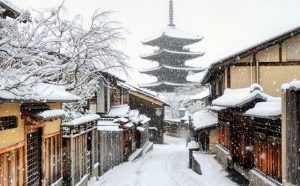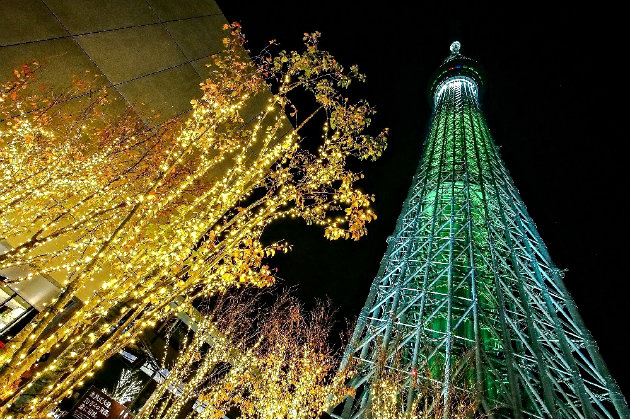WINTER IN KYOTO
 Do not let the winter cold ruin your mood! In winter, walks in Kyoto are filled with special magic. In addition, if you come to the old capital of Japan for Christmas or New Year, you will not have a single excuse to sit all day at the hotel.
Do not let the winter cold ruin your mood! In winter, walks in Kyoto are filled with special magic. In addition, if you come to the old capital of Japan for Christmas or New Year, you will not have a single excuse to sit all day at the hotel.
To make your vacation easy and enjoyable, we have compiled a list of recommendations on what to do and where to go in Kyoto in the winter. Starting from hot springs (onsen) and ending with the New Year’s festival in a traditional Shinto temple. A trip to winter Kyoto will be remembered as an amazing acquaintance with unique Japanese culture.ONSEN
The best way to relax after a long trip is to swim in the hot springs. As soon as you plunge into warm water, all your worries will leave you, and the delightful nature surrounding onsen will bring your thoughts long-awaited peace. In Kyoto, you can find several ryokans that offer open onsen, massage services and even private baths.
TEA CEREMONY
If you want to get acquainted with the culture of Japan, you should definitely participate in the Japanese tea ceremony. The philosophy of chado (jap. “The way of tea”) concerns not only the methods of preparing this drink: the owner conducts a whole ritual – refined, detailed and unhurried. Each cup of tea is prepared with meticulous meticulousness. You will be pacified both by the tea party itself, and by observing the preparations for it.
SKI RESORTS
Compared to the northern islands of Japan, for example, Hokkaido, Kansai has few places where you can engage in active winter sports. However, suitable offers will be found even for lovers of skiing and snowboarding. Although there is very little snow in Kyoto, you can go to the mountains at any time: there the white fluffy integument lingers for long weeks and even months!
MUSEUMS
Do not let the cold lock you in a warm and comfortable hotel! In winter, Kyoto hosts a huge number of exhibitions that cover a wide variety of topics: art, history, cooking and much more. You can get acquainted with the culture of Japan, take refuge from the winter cold and have fun – after all, who said that museums should be boring? We especially recommend visiting the Kyoto National Museum, the Sake Gekkeikan Museum, the Raku Museum, and the National Museum of Modern Art.
Yu-dofu
Without a doubt, long walks through winter Kyoto will awaken a brutal appetite. Therefore, we offer to try tofu – a dish that was previously available only to priests and the Emperor’s family. Go to any restaurant of traditional Japanese cuisine and order yu-tofu (boiled tofu). It is customary to serve with a delicious traditional side dish, which will especially please vegetarians.
OKERA MAYRI
When ordering a winter tour to Japan, try to catch the Japanese New Year – osegatsu. This is the most important holiday of the year, which is celebrated in all the major temples of the Old Capital. You can also witness the unusual Japanese ritual of Okera-Mayri; It takes place annually at Yasaka Temple on New Year’s Eve. After offering prayers for health and prosperity, the Japanese set fire to the end of a tightly twisted bamboo cord in temple braziers, which they then unwind in the air to hold a smoldering flame. An unforgettable sight.
HATSUMODE
On New Year’s Eve, at about midnight, Buddhist temples begin the ritual of cleansing from 108 sinful thoughts. To do this, they make 108 bells. This sacred tradition is called joey kane, and immediately followed by Hatsumode – the feast of the first visit to the temple. People go to the nearest shrines to pray and take omikuji (small paper predictions) for good luck. If you come across omikuji with a bad foreknowledge, you can tie it to a twig so that misfortunes pass you by. We recommend visiting the temples of Nanzen-ji, Chion-in, Heian-jing, as well as Fushimi Inari.
SETSUBUN
Setsubun is held on the third or fourth of February. This is a holiday anticipating the beginning of spring. It is customary for the Japanese to scatter fried beans, repeating the spell: Fuku wa uchi, oni wa soto (Jap. “Happiness in the house, demons out!”) – it is believed that this ritual drives away evil spirits. This event can be celebrated in Yoshida Shrine.
Also in February, the Kyoto restaurant festival is held, in which more than 180 shops and restaurants from all over the city take part. Each institution offers visitors a special menu and huge discounts. You can enjoy delicious seasonal ingredients at an attractive price!



